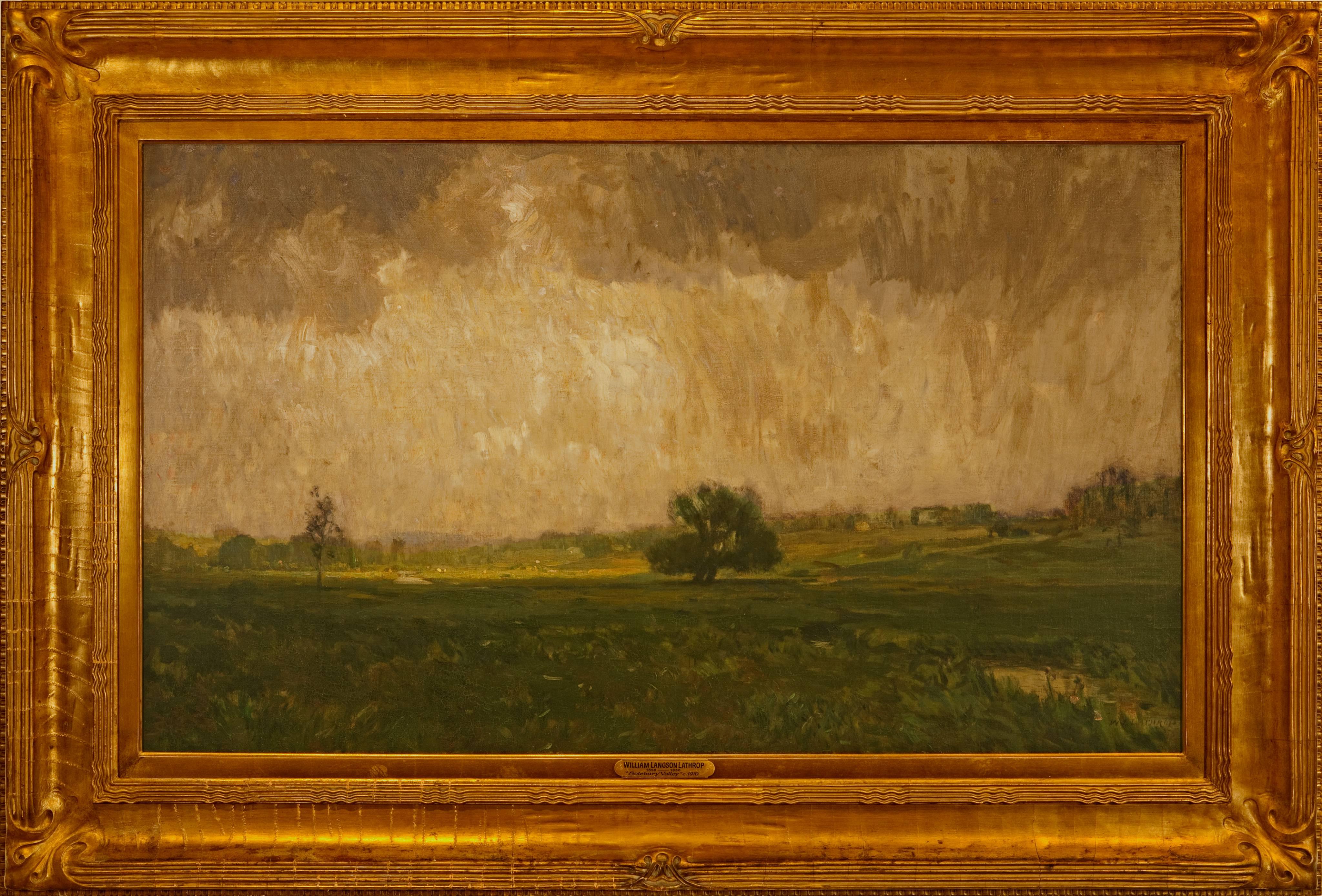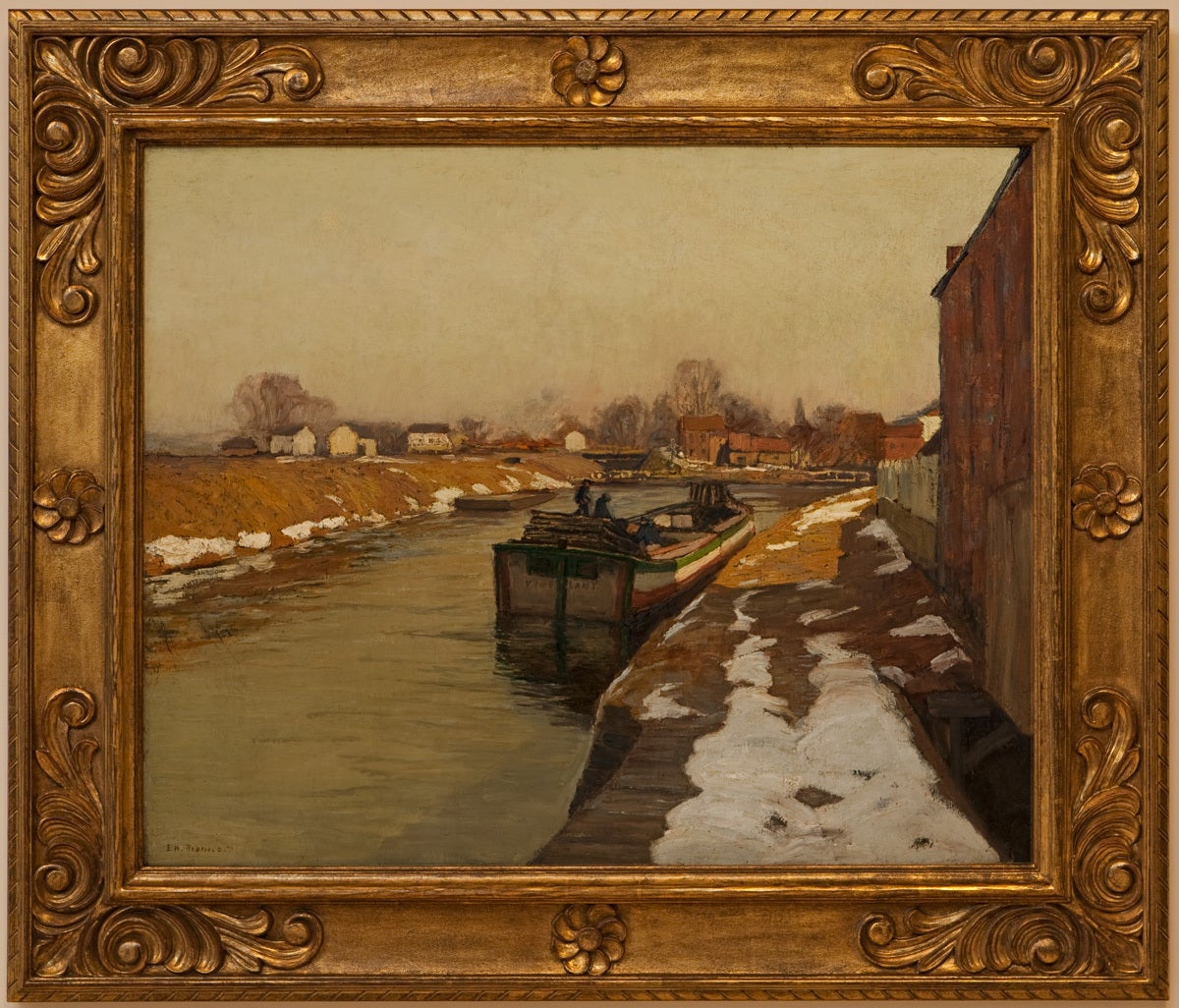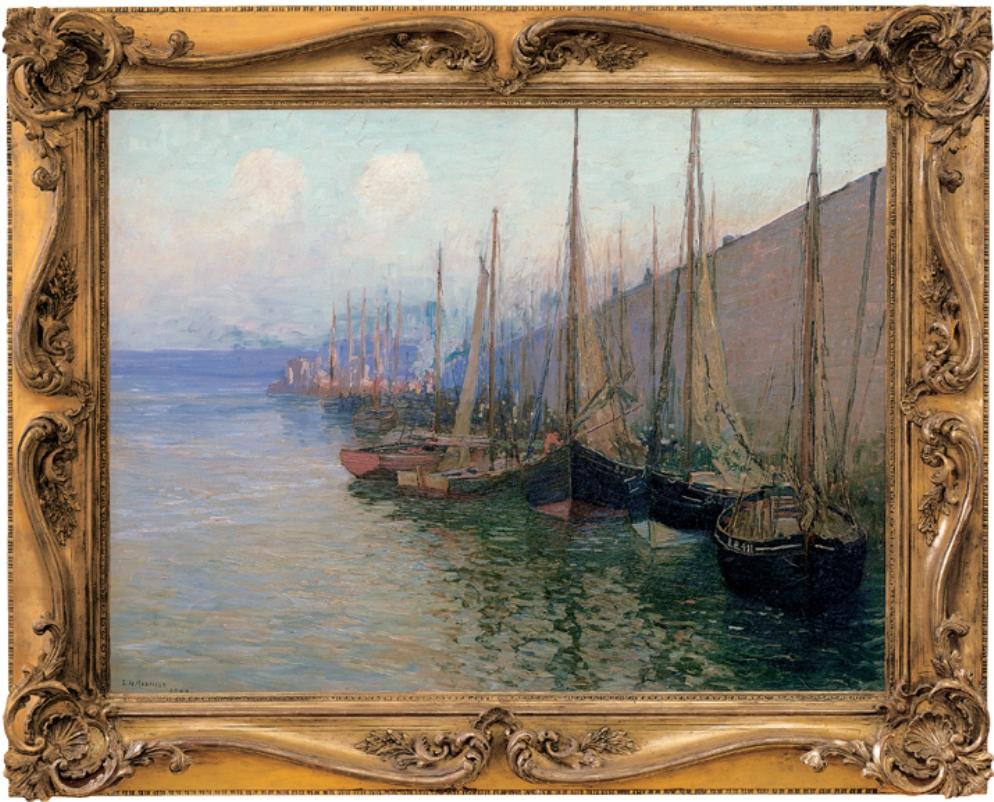Want more images or videos?
Request additional images or videos from the seller
1 of 14
William WendtLaguna Hills
About the Item
A painting by William Wendt. "Laguna Hills" is an impressionist landscape, oil on canvas in an earth-tone palette by American artist William Wendt. The artwork is signed in the lower right, "William WEDNT".
William Wendt was born in Bentzen, Germany, and immigrated?to Chicago in 1880. Although he took classes for a short time at the Art Institute of Chicago, he was a largely self-taught painter with a religious reverence for nature. Wendt co- founded the California Art Club in 1911, and within a year he was elected to the National Academy of Design and built his home and studio in Laguna Beach.
Often referred to as the “dean of Southern California artists,” he became known for his ability to scout locations for ideal, naturally occurring compositions. His earlier, Edenic landscapes exude the hallmark lightness of traditional Impressionism, but he distinguished his work with bolder, block-style pastoral compositions with muted colors.
The masculine quality had an influential effect on the style of paintings in the American West. “Wendt’s canvases grew in strength and boldness over his forty years of painting,” Nancy Moure wrote in her comprehensive book, California Art: 450 Years of Painting & Other Media (Dustin Publishing, 1998). “He soon began to ‘draw’ with his brush, to carve out the underlying structure of the mountains, delighting in the folds of the earth.”
Provenance:
with DeRu's Fine Art
Private Collection, Ohio
- Creator:William Wendt (1865 - 1946, American)
- Dimensions:Height: 25 in (63.5 cm)Width: 30 in (76.2 cm)
- Medium:
- Movement & Style:
- Period:
- Condition:
- Gallery Location:Palm Desert, CA
- Reference Number:
About the Seller
4.8
Recognized Seller
These prestigious sellers are industry leaders and represent the highest echelon for item quality and design.
Established in 1996
1stDibs seller since 2011
102 sales on 1stDibs
Typical response time: 5 hours
- ShippingRetrieving quote...Ships From: Jackson, WY
- Return PolicyA return for this item may be initiated within 7 days of delivery.
More From This SellerView All
- Spring SunsetBy Ralph WaterhouseLocated in Palm Desert, CAA painting by Ralph Waterhouse. "Spring Sunset" is a landscape painting, oil on canvas laid on board in a palette of oranges and greens by American artist Ralph Waterhouse. The artwo...Category
20th Century American Impressionist Landscape Paintings
MaterialsOil, Canvas, Board
- California LandscapeBy William WendtLocated in Palm Desert, CA"California Landscape" is a painting by California Impressionist William Wendt. The painting is signed lower left, "William Wendt 1917". The frame...Category
1910s American Impressionist Landscape Paintings
MaterialsCanvas, Oil
- Below Twin PeaksLocated in Palm Desert, CAA painting by Gertrude Partington Albright. "Below Twin Peaks" is a landscape painting, oil on canvas in an earth-tone palette by artist Gertrude Partington...Category
20th Century Impressionist Landscape Paintings
MaterialsOil, Canvas
- Loch Choire, ScotlandBy Winston ChurchillLocated in Palm Desert, CA"View of Loch Choire" is an oil on canvas board painting made by Winston Churchill in 1919. The artwork size is 17 7/8 x 14 inches. The framed size 22 1/8 x 18 1/8 x 2 3/8 inches. Th...Category
Early 20th Century Impressionist Landscape Paintings
MaterialsCanvas, Oil
- The Bay of EzeBy Winston ChurchillLocated in Palm Desert, CA"The Bay of Eze" is an oil on canvas work painted by Winston Churchill in 1958. The artwork size is 24 x 18 inches. The framed size is 29 5/8 x 23 1/2 x 2 1/4 inches. The painting is signed lower right, "WSC". Located on the French Riviera between Nice and Monte Carlo, the Bay of Eze is renowned for its stunning location and spectacular views. As you can see on pages 80-81 of Rafferty's book, this painting skillfully captures the dizzying heights, set just west of Lou Sueil, the home of Jacques and Consuelo Balsan...Category
Mid-20th Century Impressionist Landscape Paintings
MaterialsOil, Canvas
- By Lake LuganoBy Winston ChurchillLocated in Palm Desert, CA"By Lake Lugano" is an oil on canvas painting by Winston Churchill, made circa 1945. The artwork size is 22 x 28 inches. The framed size...Category
Mid-20th Century Impressionist Landscape Paintings
MaterialsCanvas, Oil
You May Also Like
- "Alley Fiends"By John R. GrabachLocated in Lambertville, NJJim’s of Lambertville is proud to offer this artwork by: John R. Grabach (1886 - 1981) John Grabach was a highly regarded New Jersey artist, teacher, and author of the classic text...Category
1930s American Impressionist Landscape Paintings
MaterialsCanvas, Oil
- "Forest Strongholds"By John F. CarlsonLocated in Lambertville, NJSigned lower right. Complemented by a hand carved and gilt frame. Exhibited at the National Academy of Design, 1928Category
20th Century American Impressionist Landscape Paintings
MaterialsCanvas, Oil
- "Solebury Valley"By William Langson LathropLocated in Lambertville, NJSigned lower right. Complemented by a period frame. William L. Lathrop (1859-1938) Deemed “Father of the New Hope Art Colony”, William Langson Lathrop was born in Warren, Illinois. He was largely self-taught, having only studied briefly with William Merritt Chase in 1887, at the Art Students League. Lathrop first moved east in the early 1880s, and took a job at the Photoengraving Company in New York City. While there, he befriended a fellow employee, Henry B. Snell. The two men became lifelong friends and ultimately, both would be considered central figures among the New Hope Art Colony. Lathrop's early years as an artist were ones of continuing struggle. His efforts to break through in the New York art scene seemed futile, so he scraped enough money together to travel to Europe with Henry Snell in1888. There he met and married an English girl, Annie Burt. Upon returning to New York, he tried his hand at etching, making tools from old saw blades...Category
1910s American Impressionist Landscape Paintings
MaterialsCanvas, Oil
- Winter MoonlightBy George William SotterLocated in Lambertville, NJsigned lower rightCategory
1910s American Impressionist Landscape Paintings
MaterialsCanvas, Oil
- "The Canal"By Edward Willis RedfieldLocated in Lambertville, NJJim’s of Lambertville is proud to offer this artwork. Signed lower left. Complemented by a hand carved and gilt frame. Illustrated in "Edward Redfield: Just Values and Fine Seeing" by Constance Kimmerle and the Pennsylvania Academy of the Fine Arts's Exhibition of Paintings by Edward Redfield (April 17 to May 16, 1909) brochure Edward Willis Redfield (1869 - 1965) Edward W. Redfield was born in Bridgeville, Delaware, moving to Philadelphia as a young child. Determined to be an artist from an early age, he studied at the Spring Garden Institute and the Franklin Institute before entering the Pennsylvania Academy from 1887 to 1889, where he studied under Thomas Anshutz, James Kelly, and Thomas Hovenden. Along with his friend and fellow artist, Robert Henri, he traveled abroad in 1889 and studied at the Academie Julian in Paris under William Bouguereau and Tony Robert-Fleury. While in France, Redfield met Elise Deligant, the daughter of an innkeeper, and married in London in 1893. Upon his return to the United States, Redfield and his wife settled in Glenside, Pennsylvania. He remained there until 1898, at which time he moved his family to Center Bridge, a town several miles north of New Hope along the Delaware River. Redfield painted prolifically in the 1890s but it was not until the beginning of the twentieth century that he would develop the bold impressionist style that defined his career. As Redfield’s international reputation spread, many young artists gravitated to New Hope as he was a great inspiration and an iconic role model. Edward Redfield remained in Center Bridge throughout his long life, fathering his six children there. Around 1905 and 1906, Redfield’s style was coming into its own, employing thick vigorous brush strokes tightly woven and layered with a multitude of colors. These large plein-air canvases define the essence of Pennsylvania Impressionism. By 1907, Redfield had perfected his craft and, from this point forward, was creating some of his finest work. Redfield would once again return to France where he painted a small but important body of work between 1907 and 1908. While there, he received an Honorable Mention from the Paris Salon for one of these canvases. In 1910 he was awarded a Gold Medal at the prestigious Buenos Aires Exposition and at the Panama-Pacific Exposition of 1915 in San Francisco, an entire gallery was dedicated for twenty-one of his paintings. Since Redfield painted for Exhibition with the intent to win medals, his best effort often went into his larger paintings. Although he also painted many fine smaller pictures, virtually all of his works were of major award-winning canvas sizes of 38x50 or 50x56 inches. If one were to assign a period of Redfield’s work that was representative of his “best period”, it would have to be from 1907 to 1925. Although he was capable of creating masterpieces though the late 1940s, his style fully matured by 1907 and most work from then through the early twenties was of consistently high quality. In the later 1920s and through the 1930s and 1940s, he was like most other great artists, creating some paintings that were superb examples and others that were of more ordinary quality. Redfield earned an international reputation at a young age, known for accurately recording nature with his canvases and painting virtually all of his work outdoors; Redfield was one of a rare breed. He was regarded as the pioneer of impressionist winter landscape painting in America, having few if any equals. Redfield spent summers in Maine, first at Boothbay Harbor and beginning in the 1920s, on Monhegan Island. There he painted colorful marine and coastal scenes as well as the island’s landscape and fishing shacks. He remained active painting and making Windsor style furniture...Category
Early 1900s American Impressionist Landscape Paintings
MaterialsCanvas, Oil
- "In Port"By Edward Willis RedfieldLocated in Lambertville, NJJim’s of Lambertville is proud to offer this artwork by: Edward Willis Redfield (1869 - 1965) Edward W. Redfield was born in Bridgeville, Delaware, moving to Philadelphia as a young child. Determined to be an artist from an early age, he studied at the Spring Garden Institute and the Franklin Institute before entering the Pennsylvania Academy from 1887 to 1889, where he studied under Thomas Anshutz, James Kelly, and Thomas Hovenden. Along with his friend and fellow artist, Robert Henri, he traveled abroad in 1889 and studied at the Academie Julian in Paris under William Bouguereau and Tony Robert-Fleury. While in France, Redfield met Elise Deligant, the daughter of an innkeeper, and married in London in 1893. Upon his return to the United States, Redfield and his wife settled in Glenside, Pennsylvania. He remained there until 1898, at which time he moved his family to Center Bridge, a town several miles north of New Hope along the Delaware River. Redfield painted prolifically in the 1890s but it was not until the beginning of the twentieth century that he would develop the bold impressionist style that defined his career. As Redfield’s international reputation spread, many young artists gravitated to New Hope as he was a great inspiration and an iconic role model. Edward Redfield remained in Center Bridge throughout his long life, fathering his six children there. Around 1905 and 1906, Redfield’s style was coming into its own, employing thick vigorous brush strokes tightly woven and layered with a multitude of colors. These large plein-air canvases define the essence of Pennsylvania Impressionism. By 1907, Redfield had perfected his craft and, from this point forward, was creating some of his finest work. Redfield would once again return to France where he painted a small but important body of work between 1907 and 1908. While there, he received an Honorable Mention from the Paris Salon for one of these canvases. In 1910 he was awarded a Gold Medal at the prestigious Buenos Aires Exposition and at the Panama-Pacific Exposition of 1915 in San Francisco, an entire gallery was dedicated for twenty-one of his paintings. Since Redfield painted for Exhibition with the intent to win medals, his best effort often went into his larger paintings. Although he also painted many fine smaller pictures, virtually all of his works were of major award-winning canvas sizes of 38x50 or 50x56 inches. If one were to assign a period of Redfield’s work that was representative of his “best period”, it would have to be from 1907 to 1925. Although he was capable of creating masterpieces though the late 1940s, his style fully matured by 1907 and most work from then through the early twenties was of consistently high quality. In the later 1920s and through the 1930s and 1940s, he was like most other great artists, creating some paintings that were superb examples and others that were of more ordinary quality. Redfield earned an international reputation at a young age, known for accurately recording nature with his canvases and painting virtually all of his work outdoors; Redfield was one of a rare breed. He was regarded as the pioneer of impressionist winter landscape painting in America, having few if any equals. Redfield spent summers in Maine, first at Boothbay Harbor and beginning in the 1920s, on Monhegan Island. There he painted colorful marine and coastal scenes as well as the island’s landscape and fishing shacks. He remained active painting and making Windsor style furniture...Category
Early 1900s American Impressionist Landscape Paintings
MaterialsCanvas, Oil
Recently Viewed
View AllMore Ways To Browse
Earth Delights
Scout Design
Antique Scout
Cowboy Horse Painting
Dutch Rush
Harbor Maine
Large Pastoral Oil Paintings
Luxembourg Gardens Paris
Modern Paintings Palm Trees
New Orleans Street Scene Paintings
P Meyer
Vintage Pastel Landscape
William Storm
Antique Chicken Art
Caribbean Plant
Italy Landscape Painting Tuscany
Manhattan Wine
Mexican Carved Frame





